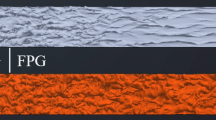Abstract
Direct numerical simulation (DNS) with high spatial/temporal resolution of spatially developing turbulent boundary layers subject to very strong favorable pressure gradient (FPG) has been performed. The sudden acceleration imposed on the flow provokes a significant attenuation of turbulent intensities (Araya et al. in J Fluid Mech 775:189–200, 2015), particularly due to the dominance of pressure forces over approximately frozen Reynolds stresses, Narasimha and Sreenivasan (Adv Appl Mech 19:221–309, 1979). In this article, visualization of the DNS velocity field is carried out in order to evaluate the effect of very strong FPG on elementary coherent structures, such as low- and high-speed streaks, sweeps and ejections, quasi-streamwise and horseshoe vortices, and large-scale motions. An important symbiosis between quasi-streamwise vortices and low-speed streaks (or regeneration cycle) has been observed in the FPG zone. The destabilizing shear layers upstream of vortex heads in strong accelerated flows appear as very thin zones developing in the buffer region (\(20<y^+< 30\)). It seems that decaying \(uv'\) in strong FPG flows (Araya et al. 2015) is principally due to the annihilation of sweeps, while ejections are responsible for the turbulence residual.
Graphical Abstract
















Similar content being viewed by others
References
Adrian RJ (2007) Hairpin vortex organization in wall turbulence. Phys Fluids 19:041301
Adrian RJ, Liu ZC (2002) Observation of vortex packets in direct numerical simulation of fully turbulent channel flow. J Vis 5:9–19
Adrian RJ, Meinhart CD, Tomkins CD (2000) Vortex organisation in the outer region of the turbulent boundary layer. J Fluid Mech 422:1–54
Araya G, Castillo C, Hussain F (2015) The log behaviour of the Reynolds shear stress in accelerating turbulent boundary layers. J Fluid Mech 775:189–200
Araya G, Castillo L, Meneveau C, Jansen K (2011) A dynamic multi-scale approach for turbulent inflow boundary conditions in spatially evolving flows. J Fluid Mech 670:518–605
Balakumar BJ, Adrian R (2007) Large- and very-large-scale motions in channel and boundary layer flows. Philos Trans R Soc A 365:665–681
Brown G, Roshko A (1974) On density effects and large structure in turbulent mixing layer. J Fluid Mech 64:775–816
Cantwell B (1981) Organized motion in turbulent flow. Ann Rev Fluid Mech 13:457–515
Dennis DJC (2015) Coherent structures in wall-bounded turbulence. Anais da Academia Brasileira de Ciencias 87:1161–1193 06
Falco RE (1977) Coherent motions in the outer region of turbulent boundary layers. Phys Fluids 20:124–132
Guala M, Hommema SE, Adrian RJ (2006) Large-scale and very-large-scale motions in turbulent pipe flow. J Fluid Mech 554:521–542
Head MR, Bandyopadhyay P (1981) New aspects of turbulent boundary-layer structure. J Fluid Mech 107:297–338
Hutchins N, Marusic I (2007) Large-scale influences in near-wall turbulence. Philos Trans R Soc 365:647–664
Hutchins N, Marusic I (2007) Evidence of very long meandering features in the logarithmic region of turbulent boundary layers. J Fluid Mech 579:1–28
Jeong J, Hussain F (1995) On the identification of a vortex. J Fluid Mech 285:69–94 2
Jimenez J, Pinelli A (1999) The autonomous cycle of near-wall turbulence. J Fluid Mech 389:335–359
Kays WM, Crawford ME (1952) The structure of turbulent shear flow. Cambridge University Press, Cambridge
Kim HT, Kline SJ, Reynolds WC (1971) The production of turbulence near a smooth wall in a turbulent boundary layer. J Fluid Mech 50:133–160
Kline SJ, Reynolds WC, Schraub FA, Runstadler PW (1967) The structure of turbulent boundary layers. J Fluid Mech 30:741–773
Launder BE (1964) Laminarization of the turbulent boundary layer by acceleration, Rept No 77. Gas Turbine Lab., MIT., Cambridge
Lund TS, Wu X, Squires KD (1998) Generation of turbulent inflow data for spatially-developing boundary layer simulations. J Comput Phys 140(2):233–258
Narasimha R, Sreenivasan KR (1973) Relaminarization in highly accelerated turbulent boundary layers. J Fluid Mech 61:417–447
Narasimha R, Sreenivasan KR (1979) Relaminarization of fluid flows. Adv Appl Mech 19:221–309
Patel VC (1965) Calibration of the Preston tube and limitation on its use in pressure gradients. J Fluid Mech 23:185–208
Runstadler PW, Kline SJ, Reynolds WC (1963) An experimental investigation of the flow structure of the turbulent boundary layer. Report MD-8, Department of Mechanical Engineering, Stanford University, Stanford
Smith CR (1984) A synthesized model of the near-wall behavior in turbulent boundary layers. In: International proceedings of 8th symposium turbulence, University of Missouri-Rolla
Smith CR, Metzler SP (1983) The characteristics of low-speed streaks in the near-wall region of a turbulent boundary layer. J Fluid Mech 129:27–54
Smith CR, Schwartz SP (1983) Observation of streamwise rotation in the near-wall region of a turbulent boundary layer. Phys Fluids 26:641–652
Smith CR, Schwartz SP (1997) On a self-sustaining process in shear flows. Phys Fluids 9:883–900
Spalart PR (1986) Numerical study of sink-flow boundary layers. J Fluid Mech 172:307–328
Sreenivasan KR (1982) Laminarescent, relaminarizing and retransitional flows. Acta Mech 44:1–48
Theodorsen T (1952) Mechanism of turbulence. In: Proceedings of 2nd Midwestern conference on fluid mechanics, Ohio State University, Columbia, OH, vol 729, pp 603–637
Winant CD, Browand FK (1974) Vortex pairing: the mechanism of turbulent mixing-layer growth at moderate Reynolds number. J Fluid Mech 63:237–255 4
Acknowledgements
Puerto Rico Louis Stokes Alliance for Minority Program. AFOSR Grant FA9550-17-1-0051. NSF-CBET Grant \(\#\)1512393. XSEDE computational allocation \(\#\)TG-CTS170006.
Author information
Authors and Affiliations
Corresponding author
Rights and permissions
About this article
Cite this article
Araya, G., Rodriguez, D. Visualization and assessment of turbulent coherent structures in laminarescent boundary layers. J Vis 21, 191–202 (2018). https://doi.org/10.1007/s12650-017-0460-4
Received:
Accepted:
Published:
Issue Date:
DOI: https://doi.org/10.1007/s12650-017-0460-4




